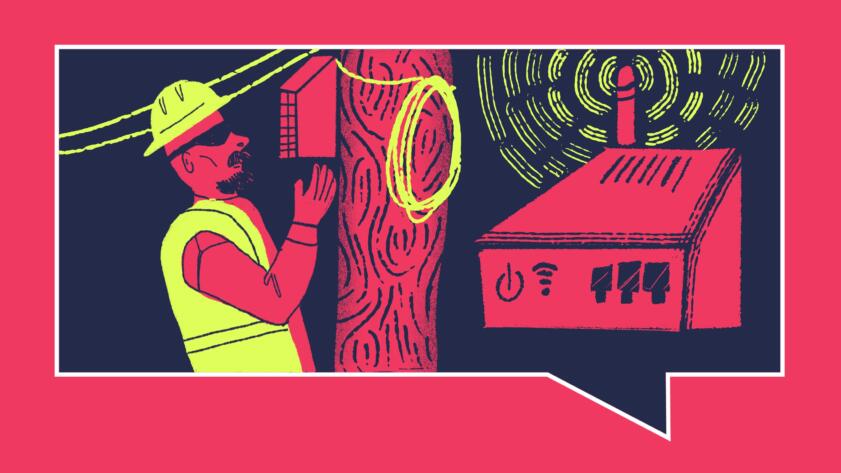The act of opening up a browser (say to read this story) may seem mindless at this point, but it’s actually the product of an incredible amount of infrastructure and opportunity that is still not available to many people in the U.S.
There are millions of people in the country who lack access to high-speed internet—though just how many millions is up for debate. The FCC’s 2021 report estimated that in 2019 about 14.5 million people lacked access to broadband, while other groups, like Broadband Now, a broadband availability research website, estimate it’s more like 42 million.
The pandemic has only made disparities in internet access more pronounced and more visible, said Gigi Sohn, a distinguished fellow at the Georgetown Law Institute for Technology Law & Policy.
”The realization was starting, but COVID just sent it to warp speed,” Sohn said.
And Congress is taking notice.
As a result, the past couple of years have seen a host of federal legislative initiatives intended to improve, expand, and regulate broadband access. The most comprehensive among them is President Joe Biden’s proposed multibillion-dollar Infrastructure Investment and Jobs Act, which includes $65 billion in broadband spending. That bill passed the Senate in August, and the House is expected to vote on the bill in late September, though this vote may be delayed.
“The headline is that this is a historic investment—a once in a generation investment—in our broadband networks,” said Doug Brake, director of broadband and spectrum policy at the Information Technology & Innovation Foundation, a think tank. (The foundation lists a trade association for broadband companies, and broadband providers themselves, as donors.)
The bill doles out about $42 billion in grants to states to build out broadband infrastructure, improve broadband maps, or increase broadband adoption programs. It also expands an existing program to help people with lower incomes pay for broadband service and requires internet service providers who take this federal money to offer lower-cost options.
Many of these proposals came, at least in part, from other legislation introduced this past year—most notably the Accessible Affordable Internet for All Act (H.R.1783/S.745) introduced by Rep. James Clyburn (SC-D) in March. But the infrastructure package does not include some key elements: faster broadband speeds for both uploads and downloads, even more funding for devices, and changes to how states treat public broadband networks.
So here are some of the biggest things the infrastructure bill does for broadband expansion—and what it doesn’t do.
Deciding How Fast Broadband Should Be
The Federal Communications Commission, the office tasked with regulating telecommunications services, has used a speed of at least 25 megabits per second (Mbps) download and 3 Mbps upload speed as a benchmark for broadband service since 2015.
You can technically get online with internet at that speed. Zoom says it requires 2 Mbps upload and download speed for a single screen, and you need about 5 Mbps of download speed to watch Netflix in HD. About three or four people could stream Netflix at 25 Mbps download speed, but streaming one Netflix show in 4K (the highest resolution offered by the service) would use up all available bandwidth.
It could also be difficult to run a small business at a speed of 25/3. A 2021 U.S. Government Accountability Office report notes that the FCC “lacks assurance that its current speed benchmark is sufficient for supporting broadband access that meets the needs of the approximately 32 million small businesses in the United States.”
17
Percent of people in the U.S. with access to a fiber network, compared with 87% of people in China
Source: BroadbandNow
And, as for working from home: “A family of four would not be able to work and study from home at speeds of 25/3,” says Christopher Ali, an associate professor of media studies at the University of Virginia.
Other countries have tried to set the bar slightly higher. The EU initially aimed to provide over 30 Mbps to everyone by 2020 but fell short of that goal. China, on the other hand, has heavily invested in fiber networks (the gold standard, capable of providing speeds far beyond 25/3). In 2019, about 87 percent of consumers in China had access to a fiber connection, compared to 17 percent of people in the U.S., according to a report from BroadbandNow.
The infrastructure bill, if passed as is, will require new broadband projects to provide 100 Mbps of download speed and 20 Mbps of upload speed.
But the infrastructure bill falls short of providing what some advocates say is necessary: “symmetrical” upload and download speeds.
The Accessible Affordable Internet for All Act, which is technically still before the Senate Committee on Commerce, Science, and Transportation, would have required most new broadband projects to deliver 100 Mbps upload and 100 Mbps download speeds. However, with the infrastructure bill in the final stages, this bill is unlikely to go anywhere.
Establishing a higher and symmetrical speed standard for new broadband projects would have at least one immediate effect, says Ali. It would make older technologies, like DSL, cable, or certain satellite services too slow to qualify as broadband.
Instead, it starts to move the standard for broadband service toward fiber networks.
Technologies like satellite, cable, or DSL might be able to hit the 100 Mbps download speeds, but the only technology that reliably hits that 100 Mbps upload speed is the fiber optic network.
“We start to weed out ‘good enough’ broadband,” said Ali.
The infrastructure bill falls short of this standard and keeps the lopsided definition of broadband service alive. The effect of this is that slower technologies will still be fundable, said Ali.
More Funding for Internet Service and Devices
Under the current version of the infrastructure bill, each state would receive $100 million. States have to submit a plan to explain what they’ll do with that money, but it might be used to award subgrants to internet service providers (like companies) or, if they exist, municipal broadband projects (more on that later). It might also be used for mapping projects or other programs aimed at increasing broadband adoption.
States that have the worst broadband availability issues will receive additional sums.
The money is intended to flow first to areas that don’t reach minimum broadband speeds of 25 Mbps download speeds and 3 Mbps upload speeds. Often (but not always) places lacking those speeds are rural or tribal lands. Only 82.8 percent of rural areas and 79.1 percent of tribal lands have broadband at minimum speeds, per the 2021 FCC report. Additionally, there’s $2 billion in the bill specifically earmarked for rural projects and another $2 billion dedicated to a fund for tribal broadband projects.
Improving access to broadband doesn’t just mean that newer and faster networks need to be built. It also means that the affordability of broadband service needs to be addressed. Forty-five percent of non-broadband users cited cost as one reason they don’t have internet service, according to a 2021 survey by the Pew Research Center.
The infrastructure bill pledges $14 billion in funding for affordability projects, including extending a federal discount on broadband called The Emergency Broadband Benefit, which offers a $50 discount on broadband service for low-income families. (The new program would offer only $30 off.)
Other proposals are looking to fill other gaps. For instance, there are proposals directed at the hardware side of things, with the recognition that not everyone has the proper machinery to get online.
The Device Access for Every American Act, introduced in the House in September, aims to increase subsidies for purchasing computers to $400 for low-income families that currently qualify for a $100 subsidy. This bill, and its $5 billion price tag, was introduced after the infrastructure bill passed the Senate and is not part of that proposal.
The infrastructure bill also didn’t boost funds for the Emergency Connectivity Fund, a broadband project created in response to the COVID-19 pandemic. That fund has dished out about $7 billion to schools and libraries for purchasing laptops, tablets, modems, routers, and wifi hotspots that kids could use to connect to the internet at home.
The Emergency Connectivity Fund got its initial funding from the American Rescue Plan Act, a COVID-19 relief bill. Other proposals have looked to secure additional funds so this program doesn’t run dry. For example, the Securing University Communications Connectivity to Ensure Students Succeed Act, or the SUCCESS Act, introduced in July, would provide $8 billion each year for five years to that fund.
The Debate over Public Broadband Networks
The “meta-debate” within broadband policy, said Brake of the telecom-funded policy group, hinges on one question: Do we want broadband solely as a privately provided service or should governments also provide broadband networks?
Municipal broadband is an alternative to companies like Spectrum or Comcast. It already exists in some places: Chattanooga, Tenn., is one area of the country that’s been lauded for its municipal broadband network. About 600 communities are currently served with some form of municipal broadband network, according to Muninetworks.org, a municipal broadband advocacy site.
However, about 18 states have laws either explicitly banning municipal broadband networks or imposing significant restraints on them. Supporters of these laws argue that banning municipal networks would promote competition and that municipal networks are costly and can’t innovate as fast as the private sector. But proponents argue municipal broadband itself actually promotes competition and leads to faster and lower cost service.
18
Number of states that have laws either banning or imposing significant restraints on municipal broadband networks
In Montana, the government is barred from providing internet service unless there is no private network option. In Florida, there’s no explicit ban, but government-run networks are subject to extra taxes, and if the network isn’t profitable in four years, a hearing can be held to end the project.
The infrastructure bill does allow states to use funds for public broadband projects, but it doesn’t preempt state laws banning municipal networks. (Biden initially pushed for “lifting barriers that prevent municipally-owned or affiliated providers and rural electric co-ops from competing.”)
Some broadband proposals before Congress have attempted to loosen restrictions on public broadband.
The Accessible Affordable Internet for All Act includes a provision that would not allow any state laws or procedures to hamper a public broadband project, public-private project, or cooperative project. Another proposed bill, The Community Broadband Act of 2021, introduced to the House in March, aims to achieve the same thing by amending the Telecommunications Act of 1996.
Other proposals, though, look to extend laws prohibiting government-run broadband. The Communities Overregulating Networks Need Competition Today Act, or the CONNECT Act, introduced to the House in February, seeks to prohibit states from offering broadband networks unless those networks already exist and there is no more than one other private competitor.
The infrastructure bill splits the difference. It doesn’t ban municipal broadband, nor does it prioritize it. This leaves the states to decide how they want to approach public broadband projects.
Corrections
A previous version of this story attributed the findings of a 2021 survey showing that 45 percent of broadband users cite cost as one reason they don’t have internet service to Pew Charitable Trusts. This survey was conducted by the Pew Research Center.
Additionally, a previous version identified Gigi Sohn as a former distinguished fellow at the Georgetown Law Institute for Technology Law & Policy. That is her current position.





